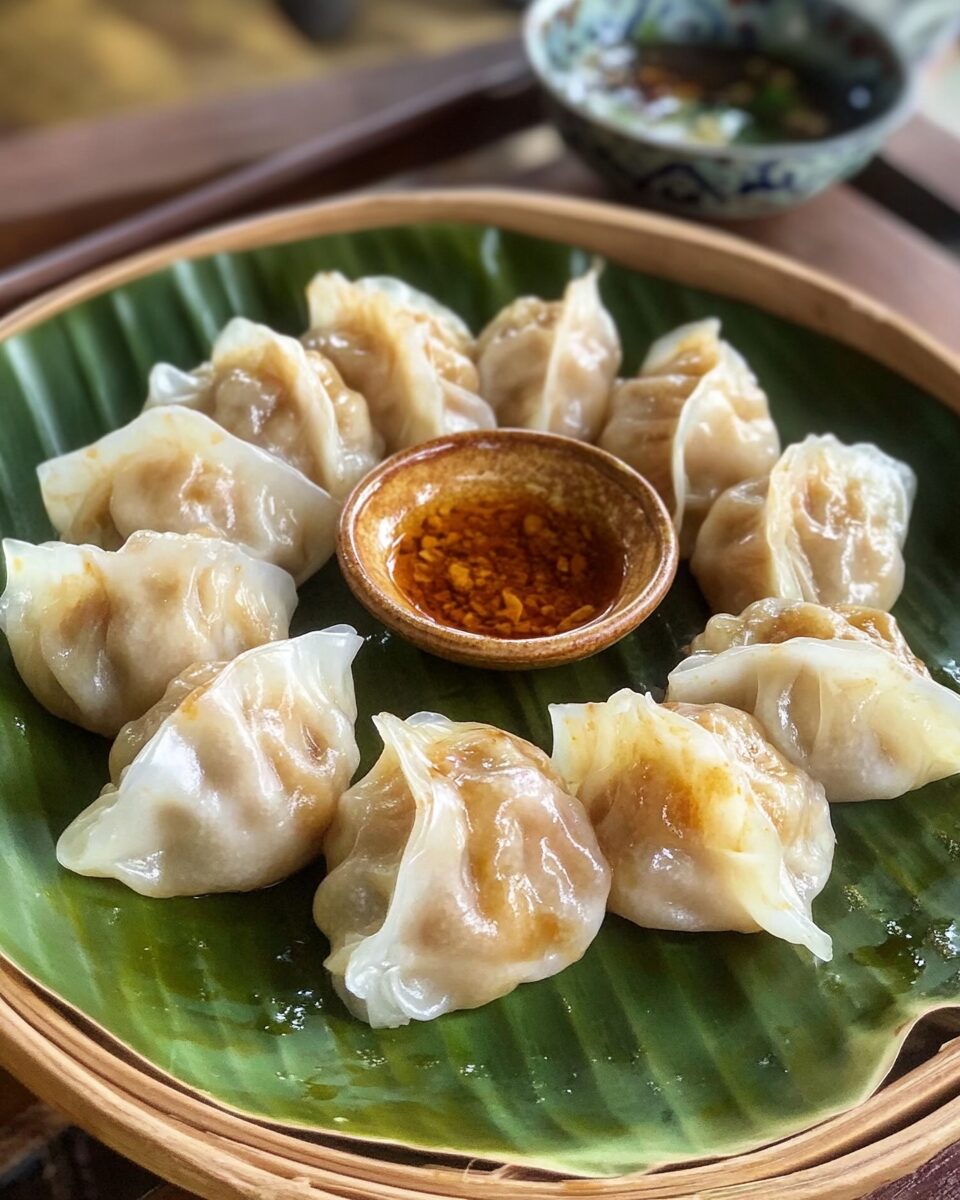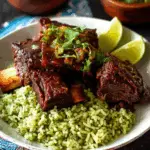Kanom Jeeb, or pleated Thai dumplings, are a flavorful fusion of minced pork, aromatic herbs, and tender vegetables wrapped in silky wonton skins. Steamed to perfection, these bite-sized delights pair beautifully with a variety of dipping sauces, making them a versatile appetizer or snack.
Whether enjoyed as part of a larger Thai feast or served solo, Kanom Jeeb offers a taste of authentic Thai cuisine that’s both comforting and elegant. Its delicate folds and enticing aroma make it a showstopper for family meals or festive gatherings.
Full Recipe:
- 14 ounces ground pork
- 1 egg
- 0.35 ounces coriander root
- 0.18 ounces black peppercorns
- 0.35 ounces garlic, minced
- 1.05 ounces carrots, finely diced
- 0.7 ounces green onions, finely diced
- 0.35 ounces dried shiitake mushrooms, finely diced
- 3 tablespoons golden mountain sauce
- 1.5 tablespoons white sugar
- 2.5 tablespoons oyster sauce
- 1 tablespoon sesame oil
- 1 tablespoon cornstarch
- 1 package of wonton wrappers
- Garlic oil for brushing
- Crispy fried garlic for garnish
Directions:
- Use a mortar and pestle to pound coriander roots, black peppercorns, and garlic into a fine paste.
- In a large mixing bowl, combine golden mountain sauce, white sugar, sesame oil, and oyster sauce.
- Add ground pork, egg, and cornstarch to the sauce mixture. Mix thoroughly or pulse in a food processor until smooth.
- Fold in the spice paste and finely diced vegetables (carrots, green onions, and mushrooms) to complete the filling.
- Place a wonton wrapper over a spoon’s concave side, pressing gently to create a well. Add filling to the center, moisten wrapper edges with water, and fold to seal, forming pleats.
- Line a bamboo steamer with parchment paper, arrange dumplings, and steam over medium heat for 10 minutes until the wrappers turn translucent.
- Brush with garlic oil and garnish with crispy fried garlic before serving hot.
Prep Time: 20 minutes | Cooking Time: 10 minutes | Total Time: 30 minutes
Kcal: 37 kcal per dumpling | Servings: 4 servings
Kanom Jeeb: The Perfect Thai Dumpling for Every Occasion
Kanom Jeeb, also known as Thai dumplings, is a delightful snack that has found its way into the hearts of food lovers around the world. With its roots in the Chinese siu mai tradition, this dish has been reimagined with authentic Thai flavors, making it a must-try appetizer for any Thai meal. Tender, juicy, and flavorful, these steamed delights are perfect for family dinners, festive gatherings, or as an exotic addition to your party spread.
The Cultural Significance of Kanom Jeeb
In Thai cuisine, snacks, or “kanom,” play an integral role in bridging meals and providing moments of culinary joy throughout the day. Kanom Jeeb, with its pleated and elegant appearance, is no exception. The term “jeeb” refers to the distinctive pleated folds of the dumpling wrappers, which mimic the aesthetic of traditional Thai designs. These dumplings are often served as appetizers but are hearty enough to double as a light meal when paired with other dishes or sauces.
In Thailand, Kanom Jeeb is a common sight at street-side stalls, bustling markets, and dim sum carts, reflecting the Thai adaptation of Chinese culinary influences. It’s not unusual to see these dumplings being freshly steamed in bamboo baskets, filling the air with their aromatic allure.
The Art of Dumpling-Making
Kanom Jeeb is as much about artistry as it is about flavor. The dumplings are traditionally shaped using thin wonton wrappers, which are folded and pleated by hand to encase the savory filling. This process not only ensures the dumplings stay intact during cooking but also gives them their distinctive, almost flower-like appearance.
The filling is where Kanom Jeeb truly shines. While pork is the traditional choice for its rich and meaty texture, variations include shrimp, chicken, or even vegetarian options. Aromatic herbs and spices such as coriander root, garlic, and black pepper are used to flavor the meat, creating a balance of savory and slightly sweet flavors. This combination is further enhanced by seasonings like oyster sauce, sesame oil, and golden mountain sauce, adding layers of umami to each bite.
Why Kanom Jeeb is So Special
One of the reasons Kanom Jeeb is so beloved is its versatility. These dumplings can be steamed, boiled, or even fried to create a crisp outer layer. While steaming is the most common preparation method, frying offers a crunchy alternative that’s equally delicious. This flexibility allows home cooks to adapt the recipe to their preferences or to the occasion.
Additionally, Kanom Jeeb can be made ahead of time and frozen, making them a convenient option for busy schedules. Whether you’re planning a dinner party or prepping snacks for the week, these dumplings can be stored and reheated without losing their signature flavor and texture.
Dipping Sauce Pairings
No Kanom Jeeb experience is complete without a dipping sauce. In Thai cuisine, sauces are considered essential, and these dumplings are often paired with a variety of options to suit different tastes.
- Thai Sweet Chili Sauce: A sweet and spicy combination that adds a tangy kick to the dumplings.
- Soy-Based Dipping Sauce: A classic choice that enhances the savory notes of the filling.
- Peanut Sauce: Creamy and nutty, this sauce brings an indulgent richness to each bite.
- Vinegar Dipping Sauce: Light and tangy, it’s perfect for cutting through the richness of the pork filling.
Encouraging experimentation with sauces allows each serving of Kanom Jeeb to feel unique and exciting.
Tips for Success
While Kanom Jeeb is relatively simple to prepare, there are a few tips to ensure your dumplings turn out perfect every time:
- Use Fresh Ingredients: Fresh herbs and vegetables will enhance the overall flavor and texture of the filling.
- Don’t Overfill: Adding too much filling can make it difficult to seal the dumplings properly, leading to leaks during cooking.
- Proper Wrapping: Pleating the wrappers not only keeps the filling secure but also ensures the dumplings cook evenly.
- Steaming Techniques: Use parchment paper or cabbage leaves to line the steamer to prevent sticking.
- Garnish for Flavor: A touch of crispy fried garlic or a drizzle of garlic oil adds a delicious finishing touch.
Serving Suggestions
Kanom Jeeb is best enjoyed fresh and hot, straight out of the steamer. However, its versatility makes it an excellent companion to other Thai dishes. Serve it alongside pad Thai, green curry, or spicy fried rice for a complete meal. For a more casual setting, pair it with a simple cucumber salad to balance the richness of the dumplings.
Variations to Explore
The beauty of Kanom Jeeb lies in its adaptability. You can customize the filling to suit dietary preferences or to use ingredients you already have at home. Here are some variations to try:
- Shrimp Dumplings: Replace or combine the pork with minced shrimp for a lighter, seafood-forward flavor.
- Vegetarian Dumplings: Use a mixture of finely chopped vegetables such as mushrooms, carrots, and cabbage, seasoned with soy sauce and sesame oil.
- Spicy Dumplings: Add a dash of chili powder or minced chili to the filling for a fiery kick.
- Fusion Dumplings: Experiment with non-traditional ingredients like cheese, spinach, or even kimchi for a unique twist.
Conclusion
Kanom Jeeb is more than just a dish—it’s a celebration of Thai culture and culinary ingenuity. Its delicate balance of flavors, intricate preparation, and versatility make it a standout choice for both novice cooks and seasoned chefs. Whether you’re hosting a dinner party or simply craving a comforting snack, these dumplings offer a delicious way to connect with Thai traditions and explore new flavors.
Perfectly steamed and paired with your favorite dipping sauce, Kanom Jeeb is sure to become a beloved staple in your kitchen. So why not gather your ingredients and try this recipe today? Your taste buds—and your guests—will thank you.






